Microsoft Entra ID
Microsoft Entra ID (ME-ID) is a cloud-based identity and access management service by Microsoft. It provides single sign-on, multifactor authentication, and access to internal and cloud developed applications. In this guide, we integrate the Microsoft Entra ID IdP to authenticate users into the Wazuh platform.
There are three stages in the single sign-on integration.
Microsoft Entra ID Configuration
Wazuh indexer configuration
Wazuh dashboard configuration
Note
You may have to request a free trial at least to complete the configuration.
Microsoft Entra ID Configuration
Create a Microsoft account or use your own if you already have one.
Go to Microsoft Azure Portal and sign in with your Microsoft account.
Create an app in Microsoft Entra ID.
Go to Microsoft Entra ID > Enterprise applications > New application and Create your own application.
Select Integrate any other application you don't find in the gallery. Give a name to your application and click Add. In our case, we name this application
wazuh-sso.

Create a role for your application.
Go back to Microsoft Entra ID and click on App registrations.

Select your new app under All applications and click App roles.
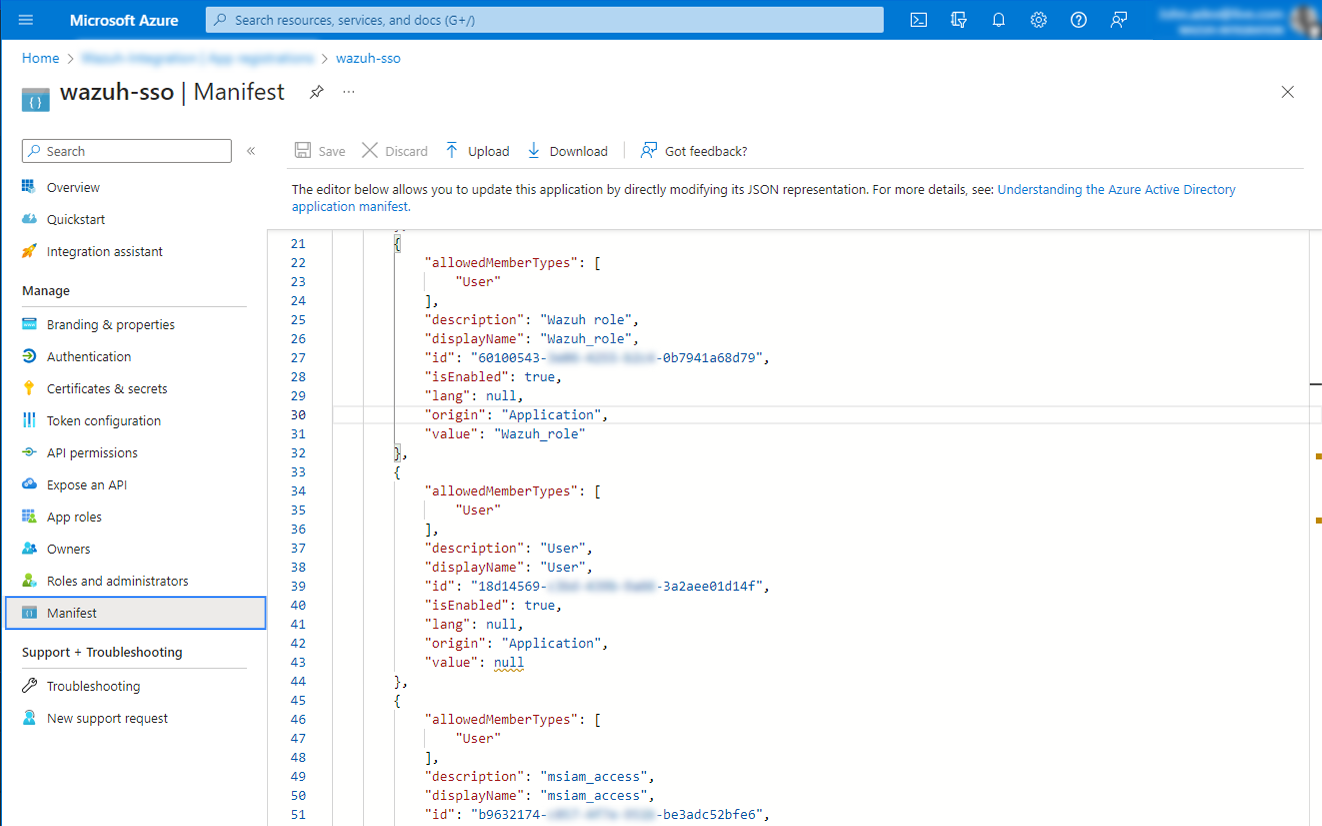
Add the following details to your app role:
Display name: This can be any value that you want. In our case this is
Wazuh_role.Allowed member types: Select Users/Groups.
Value: Defines the name of the role. In this case
Wazuh_role, which will be the backend role value to be mapped in theroles_mapping.ymlfile.Description: This can be any value that you want. In our case this is
Wazuh Admin Role.Do you want to enable this app role: Click on the checkmark to enable the role.
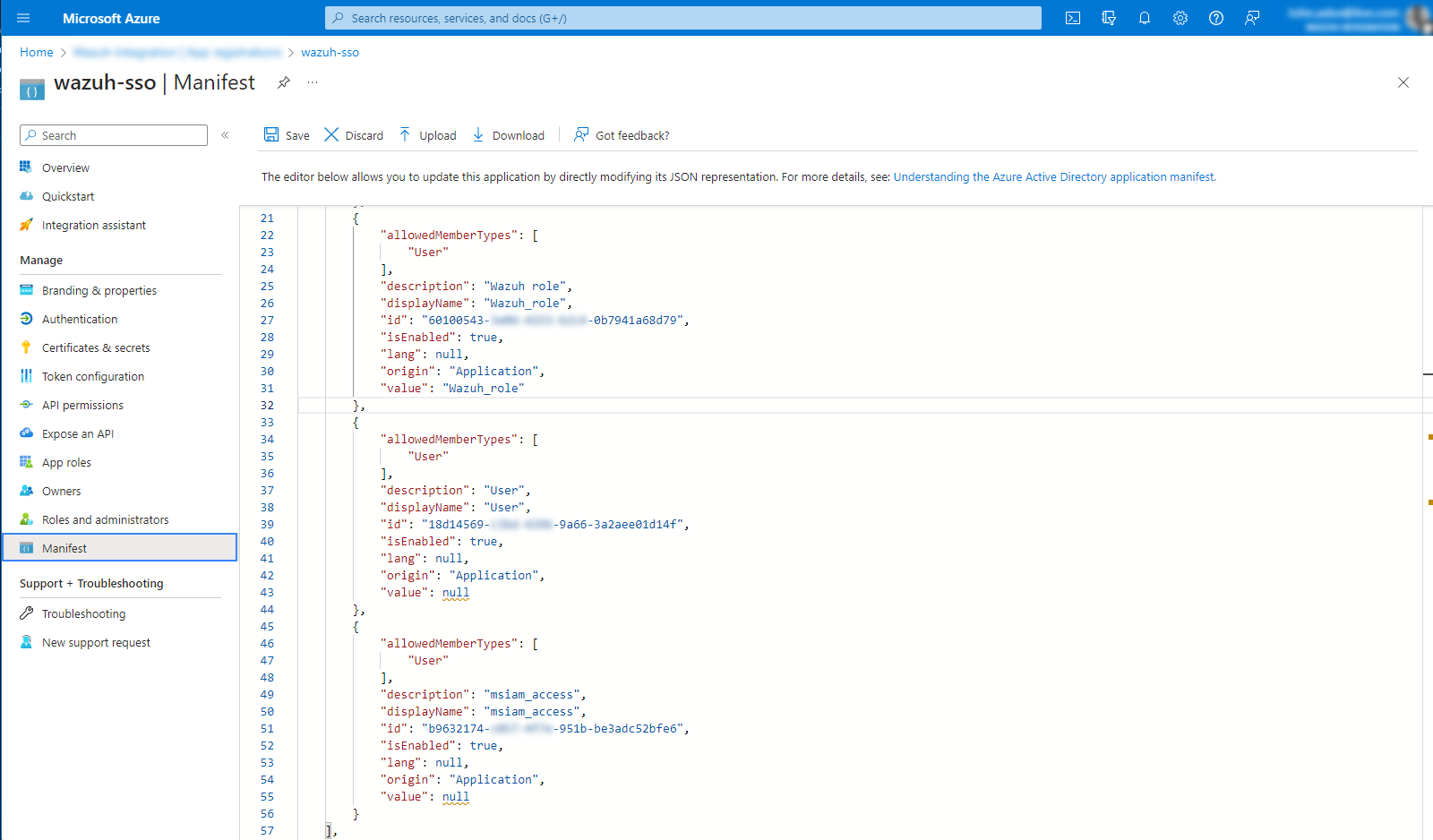
Click Apply to save the changes and proceed to the next step.
Assign a user to the app.
In Microsoft Entra ID, go to Enterprise applications, select your application and then click on Assign users and groups (or Users and Groups in the panel to the left).

Click on Add user/group, assign a user and select the role we created in Manifest.
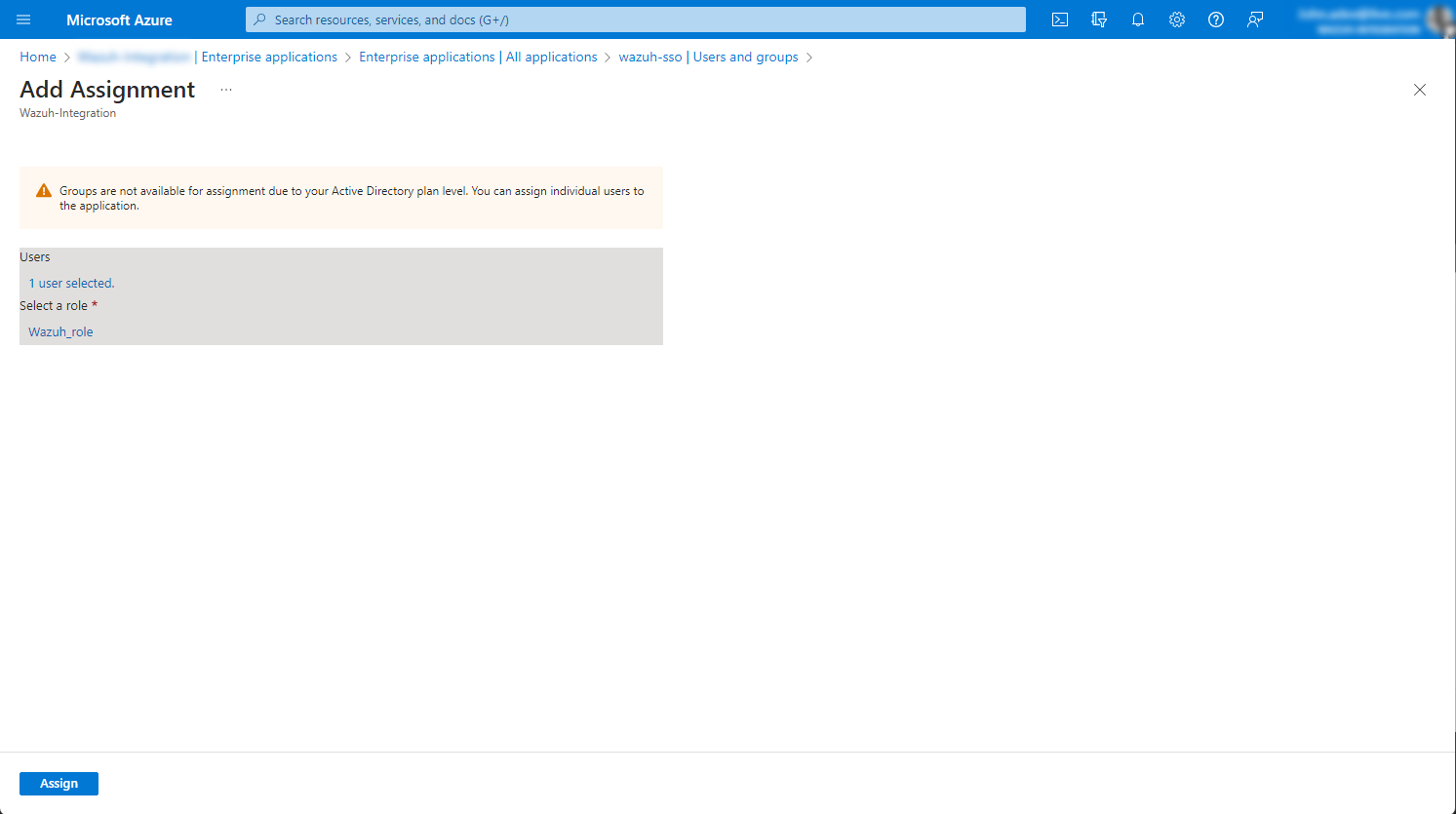
Configure Single sign-on.
Go to Enterprise applications, select your application and then click on Set up single sign-on > SAML.
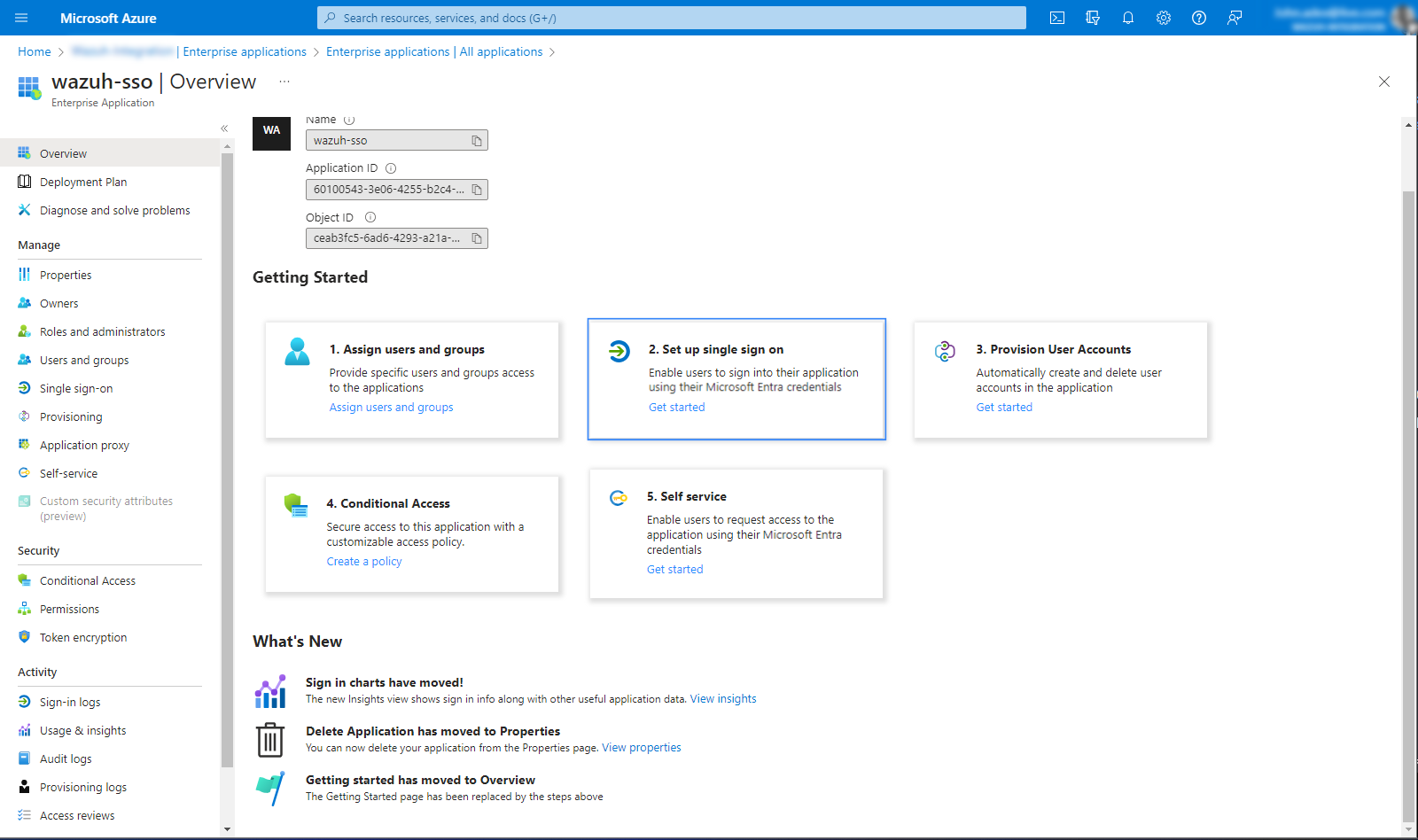
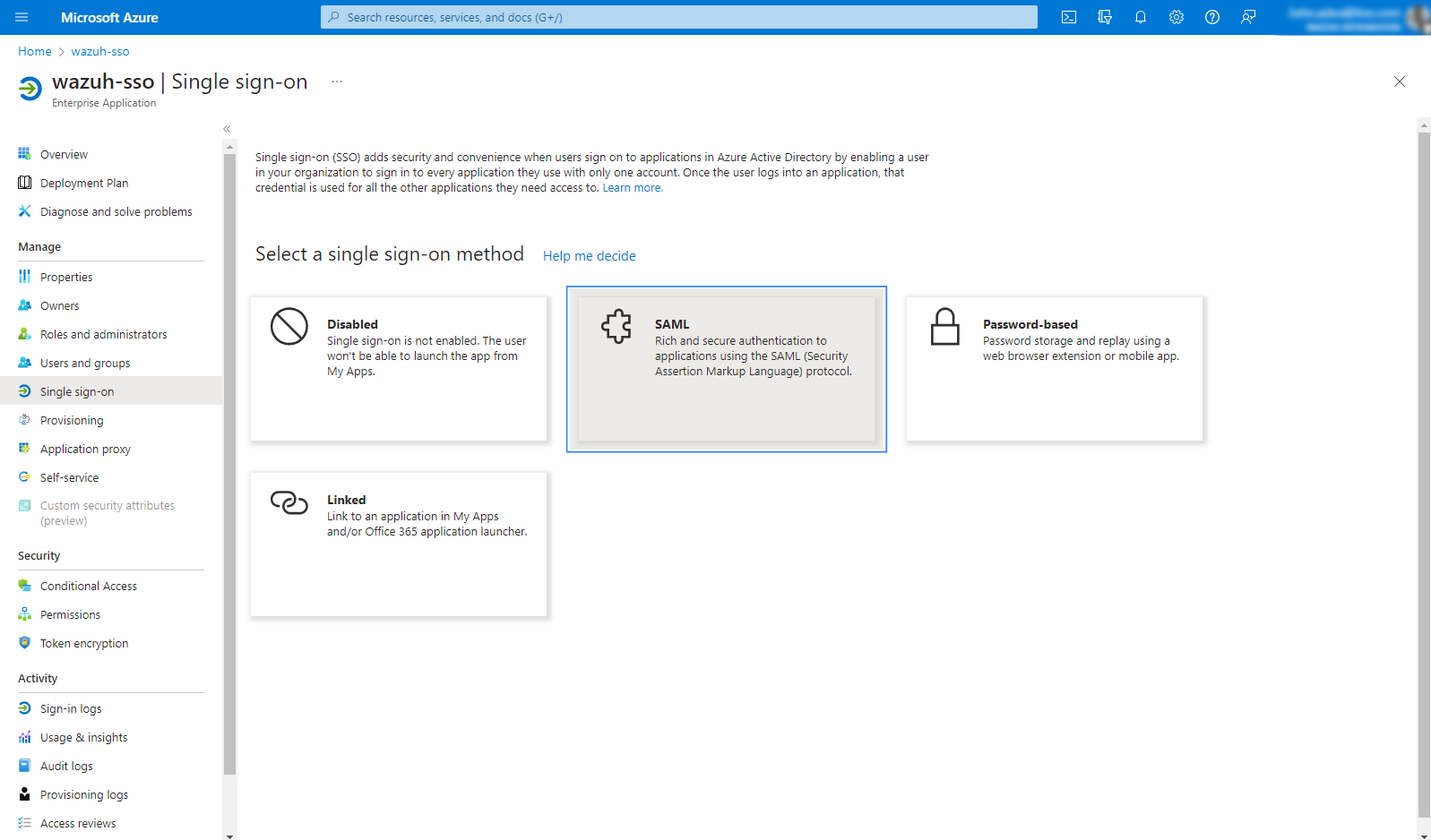
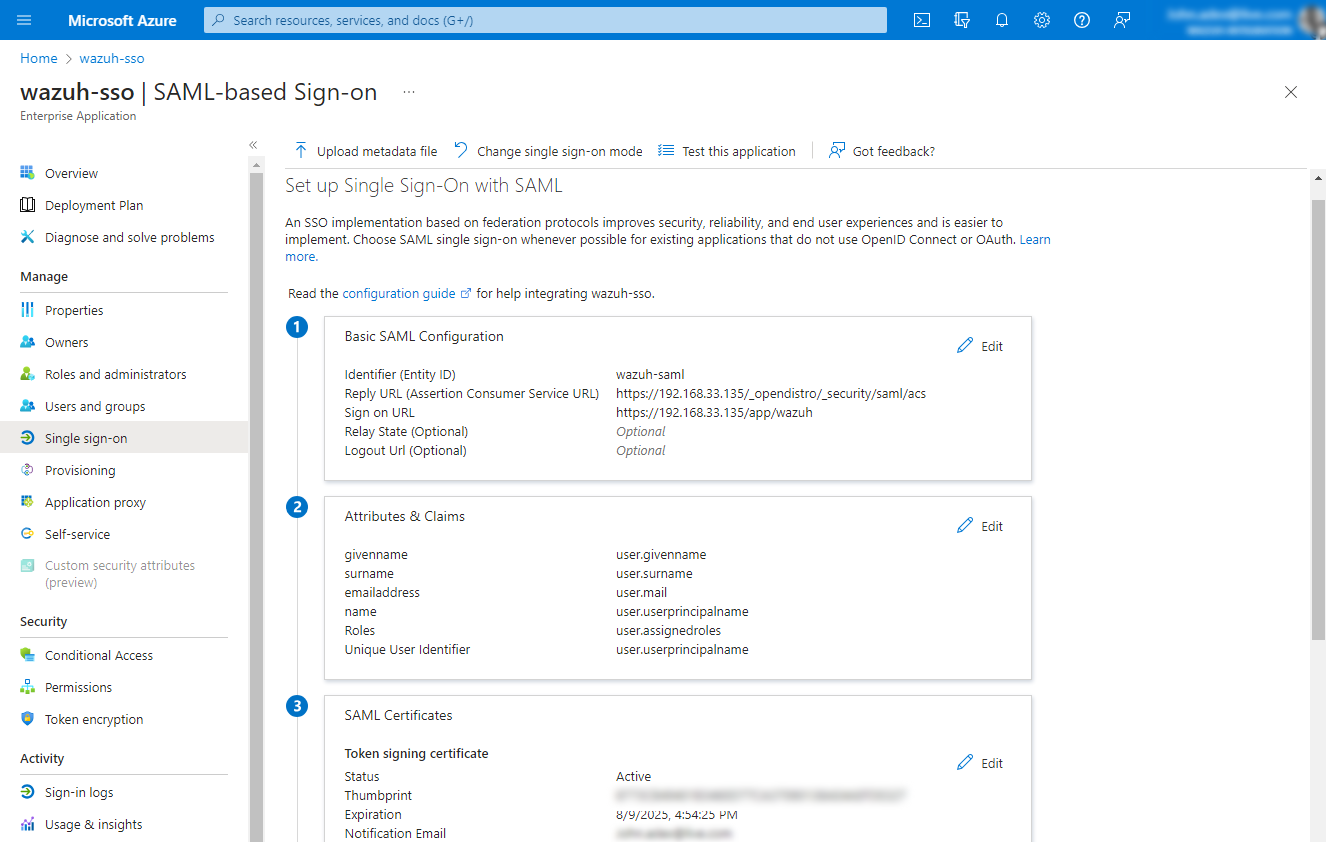
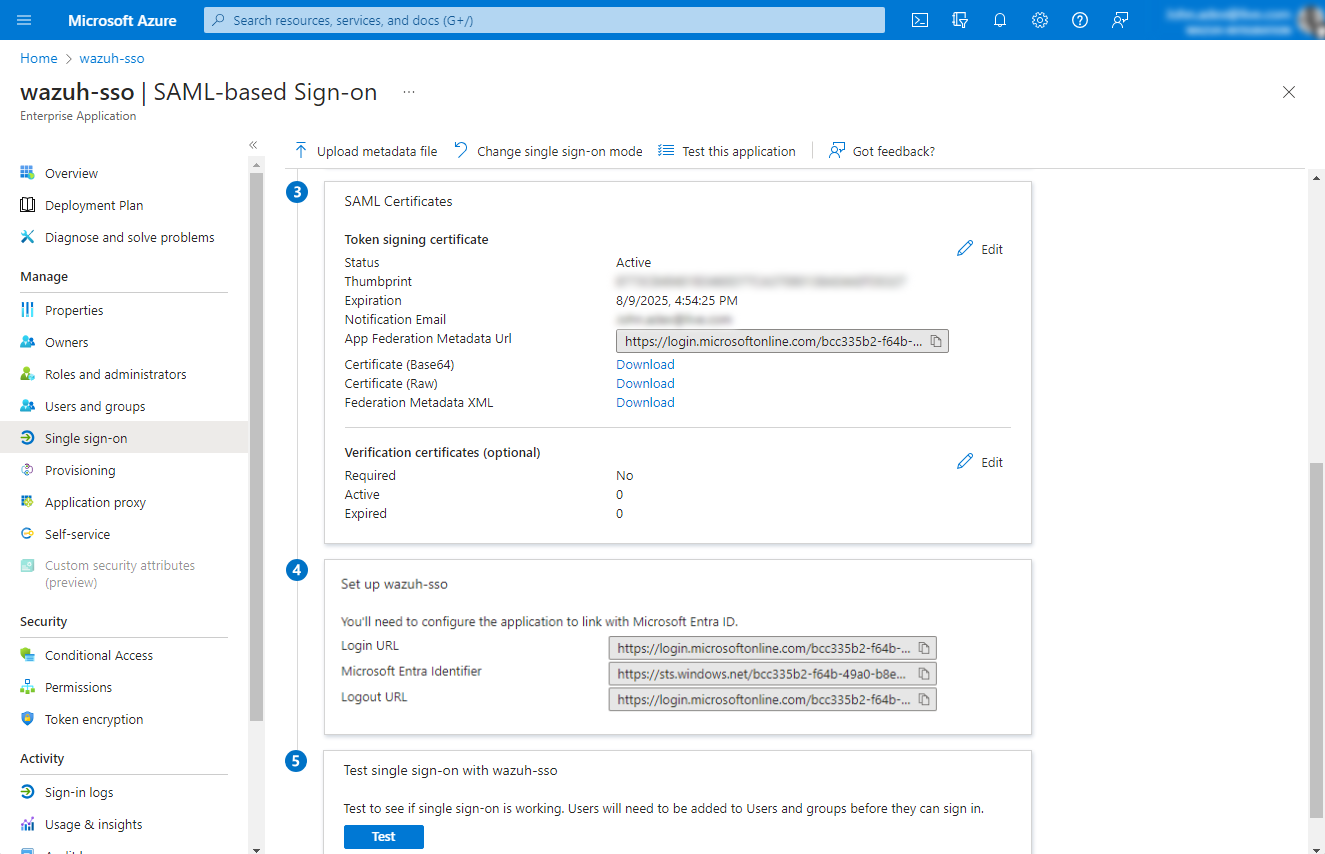
In option 1, under Basic SAML Configuration, click edit and set
wazuh-samlas Identifier (Entity ID) andhttps://<WAZUH_DASHBOARD_URL>/_opendistro/_security/saml/acsas Reply URL (Assertion Consumer Service URL), andhttps://<WAZUH_DASHBOARD_URL>as Sign on URL (Optional). Replace<WAZUH_DASHBOARD_URL>with the corresponding value. Save and proceed to the next step.
In option 2 under Attributes & Claims, click edit and select Add new claim. Select Roles as the name and user.assignedroles as Source attribute. This claim will be mapped with
roles_keyon the Wazuh indexer configuration.
Note the necessary parameters. In the Enterprise applications menu, select your application and then click on Single sign-on. Note some parameters that will be used in the Wazuh indexer configuration.
In option 3 SAML Certificate, the App Federation Metadata Url will be the
idp.metadata_urlin the Wazuh indexer configuration file.In option 4 Set up <YOUR APPLICATION>, the Microsoft Entra ID Identifier will be our
idp.entity_id.
Wazuh indexer configuration
Edit the Wazuh indexer security configuration files. We recommend that you back up these files before you carry out the configuration.
Generate a 64-character long random key using the following command.
openssl rand -hex 32The output will be used as the
exchange_keyin the/etc/wazuh-indexer/opensearch-security/config.ymlfile.Edit the
/etc/wazuh-indexer/opensearch-security/config.ymlfile and change the following values:Set the
orderinbasic_internal_auth_domainto0and thechallengeflag tofalse.Include a
saml_auth_domainconfiguration under theauthcsection similar to the following:
authc: ... basic_internal_auth_domain: description: "Authenticate via HTTP Basic against internal users database" http_enabled: true transport_enabled: true order: 0 http_authenticator: type: "basic" challenge: false authentication_backend: type: "intern" saml_auth_domain: http_enabled: true transport_enabled: false order: 1 http_authenticator: type: saml challenge: true config: idp: metadata_url: https://login.microsoftonline.com/... entity_id: https://sts.windows.net/... sp: entity_id: wazuh-saml kibana_url: https://<WAZUH_DASHBOARD_URL> roles_key: Roles exchange_key: 'b1d6dd32753374557dcf92e241.......' authentication_backend: type: noop
Ensure to change the following parameters to their corresponding value:
idp.metadata_urlidp.entity_idsp.entity_idkibana_urlroles_keyexchange_key
Run the
securityadminscript to load the configuration changes made in theconfig.ymlfile.# export JAVA_HOME=/usr/share/wazuh-indexer/jdk/ && bash /usr/share/wazuh-indexer/plugins/opensearch-security/tools/securityadmin.sh -f /etc/wazuh-indexer/opensearch-security/config.yml -icl -key /etc/wazuh-indexer/certs/admin-key.pem -cert /etc/wazuh-indexer/certs/admin.pem -cacert /etc/wazuh-indexer/certs/root-ca.pem -h 127.0.0.1 -nhnv
The
-hflag specifies the hostname or the IP address of the Wazuh indexer node. Note that this command uses 127.0.0.1, set your Wazuh indexer address if necessary.The command output must be similar to the following:
Security Admin v7 Will connect to 127.0.0.1:9200 ... done Connected as "CN=admin,OU=Wazuh,O=Wazuh,L=California,C=US" OpenSearch Version: 2.10.0 Contacting opensearch cluster 'opensearch' and wait for YELLOW clusterstate ... Clustername: wazuh-cluster Clusterstate: GREEN Number of nodes: 1 Number of data nodes: 1 .opendistro_security index already exists, so we do not need to create one. Populate config from /etc/wazuh-indexer/opensearch-security Will update '/config' with /etc/wazuh-indexer/opensearch-security/config.yml SUCC: Configuration for 'config' created or updated SUCC: Expected 1 config types for node {"updated_config_types":["config"],"updated_config_size":1,"message":null} is 1 (["config"]) due to: null Done with success
Edit the
/etc/wazuh-indexer/opensearch-security/roles_mapping.ymlfile and change the following values:Configure the
roles_mapping.ymlfile to map the role we have in Microsoft Entra ID to the appropriate Wazuh indexer role. In this case, we map theWazuh_rolein Microsoft Entra ID to theall_accessrole in Wazuh indexer:all_access: reserved: false hidden: false backend_roles: - "admin" - "Wazuh_role" description: "Maps admin to all_access"
Run the
securityadminscript to load the configuration changes made in theroles_mapping.ymlfile.# export JAVA_HOME=/usr/share/wazuh-indexer/jdk/ && bash /usr/share/wazuh-indexer/plugins/opensearch-security/tools/securityadmin.sh -f /etc/wazuh-indexer/opensearch-security/roles_mapping.yml -icl -key /etc/wazuh-indexer/certs/admin-key.pem -cert /etc/wazuh-indexer/certs/admin.pem -cacert /etc/wazuh-indexer/certs/root-ca.pem -h 127.0.0.1 -nhnv
The
-hflag specifies the hostname or the IP address of the Wazuh indexer node. Note that this command uses 127.0.0.1, set your Wazuh indexer address if necessary.The command output must be similar to the following:
Security Admin v7 Will connect to 127.0.0.1:9200 ... done Connected as "CN=admin,OU=Wazuh,O=Wazuh,L=California,C=US" OpenSearch Version: 2.10.0 Contacting opensearch cluster 'opensearch' and wait for YELLOW clusterstate ... Clustername: wazuh-cluster Clusterstate: GREEN Number of nodes: 1 Number of data nodes: 1 .opendistro_security index already exists, so we do not need to create one. Populate config from /etc/wazuh-indexer/opensearch-security Will update '/rolesmapping' with /etc/wazuh-indexer/opensearch-security/roles_mapping.yml SUCC: Configuration for 'rolesmapping' created or updated SUCC: Expected 1 config types for node {"updated_config_types":["rolesmapping"],"updated_config_size":1,"message":null} is 1 (["rolesmapping"]) due to: null Done with success
Wazuh dashboard configuration
Check the value of
run_asin the/usr/share/wazuh-dashboard/data/wazuh/config/wazuh.ymlconfiguration file. Ifrun_asis set tofalse, proceed to the next step.hosts: - default: url: https://127.0.0.1 port: 55000 username: wazuh-wui password: "<WAZUH_WUI_PASSWORD>" run_as: false
If
run_asis set totrue, you need to add a role mapping on the Wazuh dashboard. To map the backend role to Wazuh, follow these steps:Click ☰ to open the menu on the Wazuh dashboard, go to Server management > Security, and then Roles mapping to open the page.
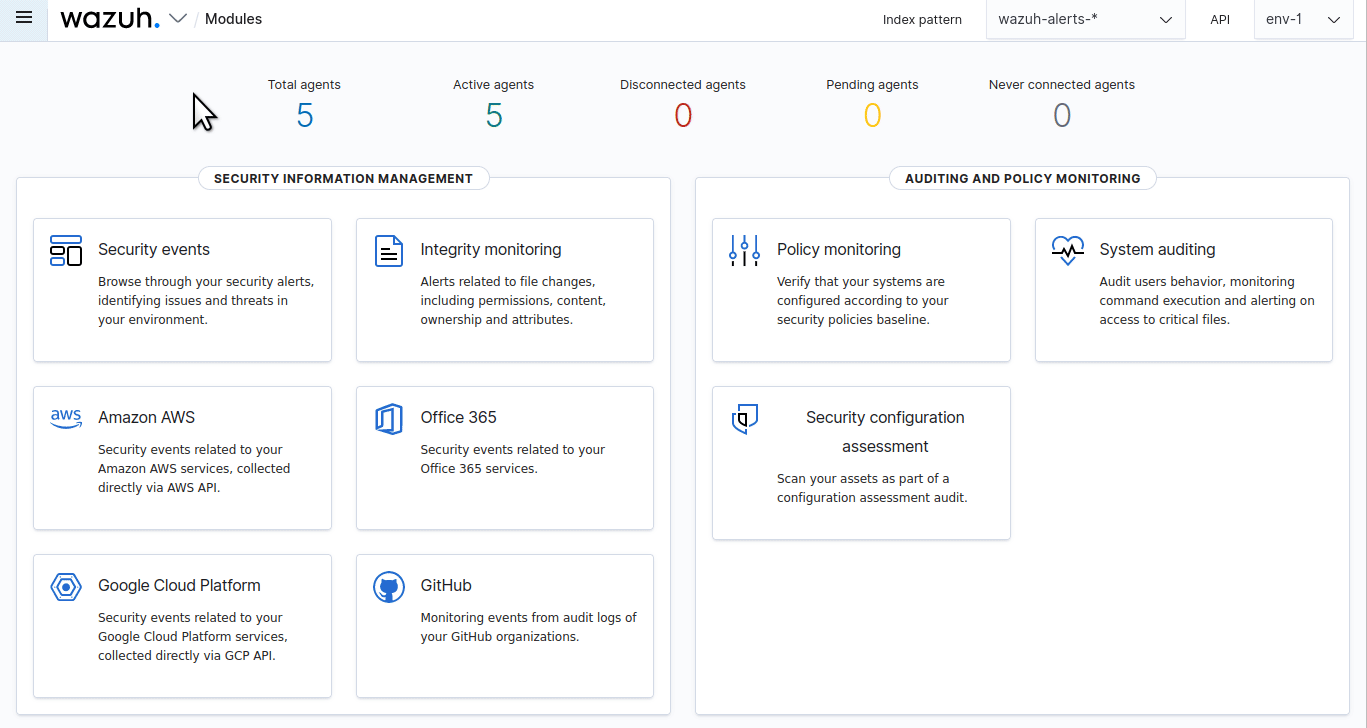
Click Create Role mapping and complete the empty fields with the following parameters:
Role mapping name: Assign a name to the role mapping.
Roles: Select
administrator.Custom rules: Click Add new rule to expand this field.
User field:
backend_rolesSearch operation:
FINDValue: Assign the backend role from the Microsoft Entra ID configuration, in our case, this is
Wazuh_role.
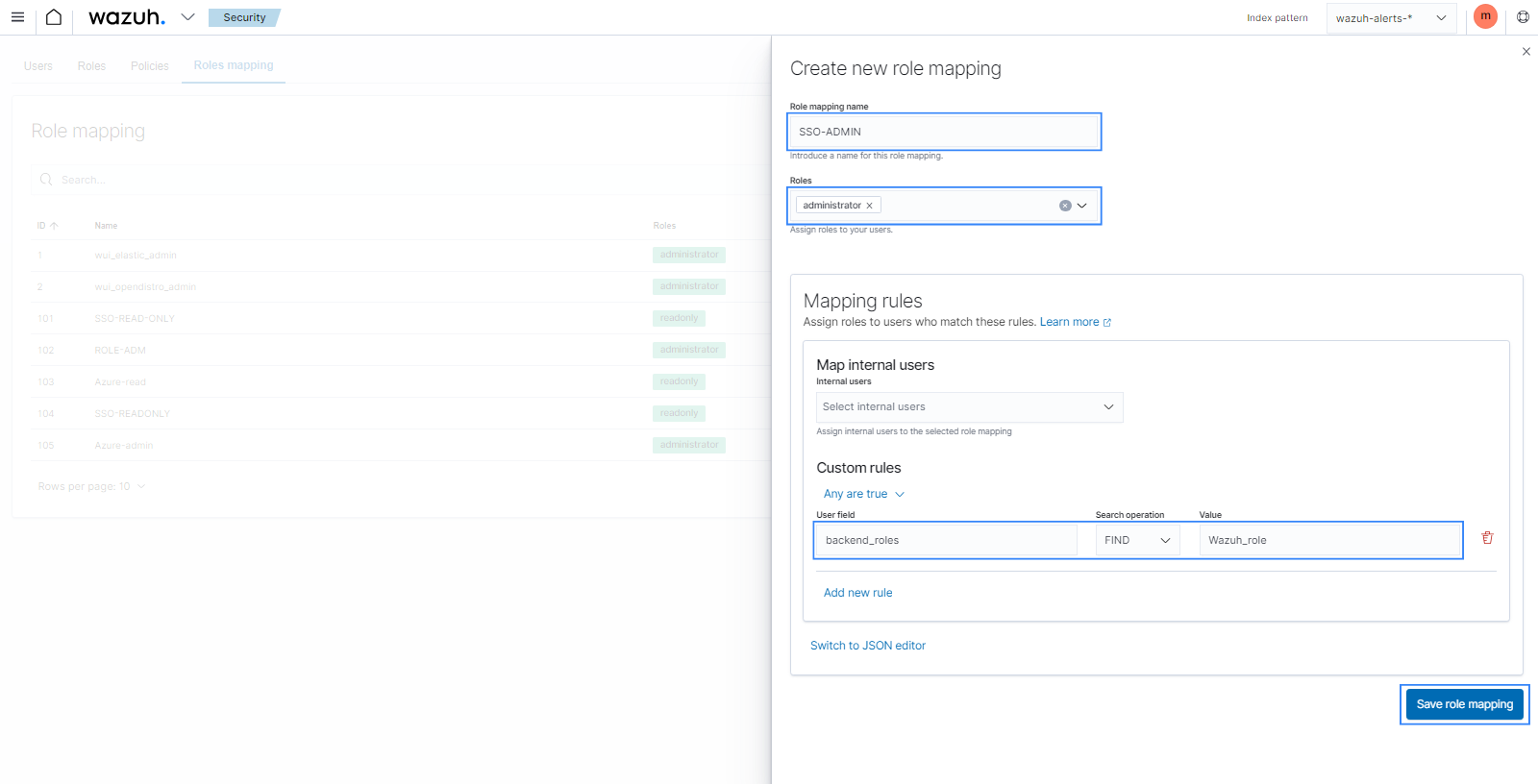
Click Save role mapping to save and map the backend role with Wazuh as administrator.
Edit the Wazuh dashboard configuration file. Add these configurations to
/etc/wazuh-dashboard/opensearch_dashboards.yml. We recommend that you back up these files before you carry out the configuration.opensearch_security.auth.type: "saml" server.xsrf.allowlist: ["/_opendistro/_security/saml/acs", "/_opendistro/_security/saml/logout", "/_opendistro/_security/saml/acs/idpinitiated"] opensearch_security.session.keepalive: false
Restart the Wazuh dashboard service.
# systemctl restart wazuh-dashboard
# service wazuh-dashboard restart
Test the configuration. Go to your Wazuh dashboard URL and log in with your Microsoft account.